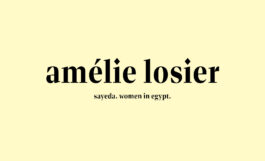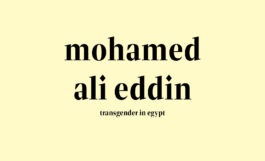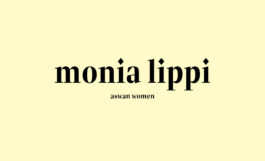













As different studies (1) show, the representation of Arabs in Western Media is highly stereotypical. Ridouani (2) for example describes the generalization of Arabs and Muslims as a deliberate and conscious strategy for stereotyping, despite the various geographical, cultural, lingual and religious differences. He claims that both terms, Arabs and Muslims, are negatively connotated and that the negative stereotypes are mythologized through their persistent repetition. This raises the question: how can a more nuanced representation of Arabs be achieved?
Looking at the specific case of Egypt, there is no study yet analyzing how women are represented in photography. Egypt is by far the country with the biggest population in the Middle East and among Arabic speaking countries (3). Egyptian media, largely controlled by the state, praise the image of “the woman whose agency is always mediated through men, that is to say, she either sacrifices for her son or husband or for the country.” (4)
This study focuses on Egypt, as an example for an Arab country, and photography as a medium. We take a closer look at photographic series that deal explicitly with a topic related to womanhood in Egypt. This allows us to include diverse photographic approaches and move beyond the already much scrutinized mass media.
To build a corps of photos to work with, we first conducted research to get a broad overview of existing photographic projects. According to the following criteria we gathered 69 photographic projects:
— that deal explicitly with women in Egypt
— by Egyptian and non-Egyptian photographers
— Time span: 2008 – 2018
— Series must consist of at least 3 photos
— We consider every person a woman who considers
herself as such, regardless of her sex
For the data collection to be as inclusive as possible, we factored in the photographer’s gender and nationality in order to find out how they influence photographic work and its perception. Therefore we include:
— 3 female Egyptian photographers
> Nariman El-Mofty: In a first, Bedouin women lead tours in Egypt’s Sinai
> Heba Khalifa: Homemade
> Lina Geoushy: Breadwinners
— 3 male Egyptian photographers
> Roger Anis: A Closet Full of Dreams
> Sabry Khaled: Khokha, street for women
> Mohamed Ali Eddin: Transgender In Egypt
— 3 female non-Egyptian photographers
> Chloe Sharrock: The purest choice
> Monia Lippi: Aswan Women
> Amélie Losier: sayeda . women in egypt .
— 2 male non-Egyptian photographers
> Denis Dailleux: Mother and Son
> Gary Calton: Women suffer under Egypt's radical rule – in pictures
In the archive you find the photographic series they were chosen for and some information to understand their approach and their photographic background. These supplementary information were gathered in additional interviews.
Based on the archive we selected a set of photos to understand the perception of these photos better. We therefore conducted workshops in Cairo in Winter 2020. To know more about our participatory image analysis see “womanhoods”.
هذا الموقع لا يزال تحت الإنشاء، والمحتوى موجود بشكل مؤقت لحين اتمام التحرير والترجمة. سوف يتم استبداله في اقرب وقت. تظهر دراسات مختلفة (1) أن تمثيل العرب في وسائل الإعلام الغربية نمطي للغاية. على سبيل المثال ، يصف رضواني (2) تعميم العرب والمسلمين على أنه استراتيجية مدروسة وواعية للقولبة ، على الرغم من الاختلافات الجغرافية والثقافية واللغوية والدينية المختلفة. وهو يدعي أن كلا المصطلحين ، العرب والمسلمون ، لهما دلالات سلبية وأن الصور النمطية السلبية يتم تحويلها إلى أساطير من خلال تكرارها المستمر. هذا يثير السؤال: كيف يمكن تحقيق تمثيل أكثر دقة للعرب؟
بالنظر إلى الحالة الخاصة بمصر ، لا توجد دراسة حتى الآن تحلل كيفية تمثيل المرأة في التصوير الفوتوغرافي. مصر هي إلى حد بعيد الدولة التي تضم أكبر عدد من السكان في الشرق الأوسط وبين البلدان الناطقة باللغة العربية (3). تمدح وسائل الإعلام المصرية ، التي تسيطر عليها الدولة إلى حد كبير ، صورة "المرأة التي تتوسط وكالتها دائمًا من خلال الرجال ، أي أنها إما تضحى من أجل ابنها أو زوجها أو من أجل الوطن". (4)
تركز هذه الدراسة على مصر كمثال لبلد عربي ، والتصوير كوسيط. نلقي نظرة فاحصة على المسلسلات الفوتوغرافية التي تتناول صراحة موضوعًا يتعلق بالأنوثة في مصر. يتيح لنا ذلك تضمين مناهج التصوير الفوتوغرافي المتنوعة والانتقال إلى ما وراء وسائل الإعلام التي خضعت بالفعل للتدقيق الشديد.
لبناء مجموعة من الصور للعمل معها ، أجرينا أولاً بحثًا للحصول على نظرة عامة واسعة على مشاريع التصوير الموجودة. وفقًا للمعايير التالية ، جمعنا 69 مشروعًا فوتوغرافيًا:
- أن تتعامل صراحة مع المرأة في مصر
- تصوير مصورين مصريين وغير مصريين
- الفترة الزمنية: 2008 - 2018
- يجب أن تتكون السلسلة من 3 صور على الأقل
- نحن نعتبر كل شخص امرأة تعتبر نفسها كذلك بغض النظر عن جنسها
من أجل أن تكون عملية جمع البيانات شاملة قدر الإمكان ، أخذنا في الاعتبار جنس المصور وجنسيته من أجل معرفة كيفية تأثيرهما على العمل الفوتوغرافي وتصوره. لذلك نقوم بتضمين:
- 3 مصورات مصريات
← ناريمان المفتي: لأول مرة ، تقود سيدات بدويات جولات في سيناء المصرية
→ هبة خليفة: محلية الصنع
← لينا الجيوشي: المعيلون
- 3 مصورين مصريين
← روجر أنيس: خزانة مليئة بالأحلام
← صبري خالد: خوخة شارع النساء
← محمد علي الدين: متحولو الجنس في مصر
- 3 مصورات غير مصريات
→ كلوي شاروك: أنقى خيار
← منيا ليبي: نساء أسوان
→ أميلي لوسير: سيدة. المرأة في مصر.
- عدد 2 مصورين غير مصريين
→ دينيس ديليوكس: الأم والابن
← غاري كالتون: المرأة تعاني في ظل الحكم الراديكالي في مصر - بالصور
تجد في الأرشيف سلسلة الصور الفوتوغرافية التي تم اختيارهم من أجلها وبعض المعلومات لفهم نهجهم وخلفيتهم الفوتوغرافية. تم جمع هذه المعلومات التكميلية في مقابلات إضافية.
بناءً على الأرشيف ، اخترنا مجموعة من الصور لفهم تصور هذه الصور بشكل أفضل. لذلك قمنا بإجراء ورش عمل في القاهرة في شتاء 2020. لمعرفة المزيد عن تحليل الصورة التشاركي ، انظر "الأنوثة".

1
Laura Navarro, „Islamophobia and Sexism: Muslim Women in the Western Mass Media,“ Human Architecture: Journal of the Sociology of Self-Knowledge: Vol. 8: Iss. 2, Article 10, (2010).
Smeeta Mishra, „Saving“ Muslim women and fighting Muslim men: Analysis of representations in The New York Times (Bowling Green State University, 2006).
Nahed Mohamed Atef El Tantawy, U.S. Newspaper Representation of Muslim and Arab Women Post 9/11. (Dissertation- Georgia State University, 2007.
2
Driss Ridouani, „The Representation of Arabs and Muslims in Wetsern Media“ Revista Universitaria de Treballs Academics No 03 (2011)
4
Shereen Abouelnaga, Women in Revolutionary Egypt – Gender and the new Geographics of Identity (Cairo: The American University in Cairo Press, 2016), 112.